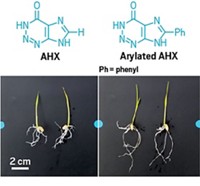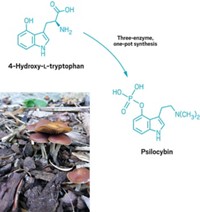Advertisement
Grab your lab coat. Let's get started
Welcome!
Welcome!
Create an account below to get 6 C&EN articles per month, receive newsletters and more - all free.
It seems this is your first time logging in online. Please enter the following information to continue.
As an ACS member you automatically get access to this site. All we need is few more details to create your reading experience.
Not you? Sign in with a different account.
Not you? Sign in with a different account.
ERROR 1
ERROR 1
ERROR 2
ERROR 2
ERROR 2
ERROR 2
ERROR 2
Password and Confirm password must match.
If you have an ACS member number, please enter it here so we can link this account to your membership. (optional)
ERROR 2
ACS values your privacy. By submitting your information, you are gaining access to C&EN and subscribing to our weekly newsletter. We use the information you provide to make your reading experience better, and we will never sell your data to third party members.
Biological Chemistry
Fairy Rings Share Magical Chemistry
Chemists find that purine natural products produced by fungi as plant growth regulators are also produced by grasses such as rice
by Stephen K. Ritter
January 27, 2014
| A version of this story appeared in
Volume 92, Issue 4
For centuries, people around the world have been mystified by the formation of circles or arcs of accelerated plant growth in woodlands and grassy fields. The rings sometimes erupt with mushrooms, adding to the intrigue. Myth and superstition led these geometric patterns of plant growth to be called fairy rings. In 2010, a research team led by Hirokazu Kawagishi of Shizuoka University, in Japan, discovered that the “fairy” is the plant-growth regulator 2-azahypoxanthine (AHX), one of several purine-based natural products made by fungi. The researchers determined how AHX is produced from 5-aminoimidazole-4-carboxamide (AICA)—a compound in the purine metabolic pathway in animals, plants, and microorganisms—and began figuring out the complete biosynthesis pathway of the compounds in hopes of finding a practical use of the plant hormones in agriculture. Kawagishi’s team has now reported the discovery of an additional AHX metabolite, 2-aza-8-oxohypoxanthine (AOH), which is produced from AHX by the enzyme xanthine oxidase. And after detecting AHX and AOH in plants such as rice, the researchers have uncovered that the plants themselves actually biosynthesize the compounds (Angew. Chem. Int. Ed. 2014, DOI: 10.1002/anie.201308109). Kawagishi is now leading an effort to isolate key enzymes in the purine biosynthetic pathways as models for new agrochemicals or for engineering genetically modified plants.






Join the conversation
Contact the reporter
Submit a Letter to the Editor for publication
Engage with us on Twitter